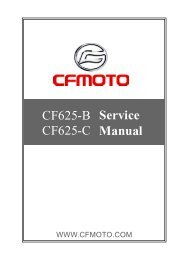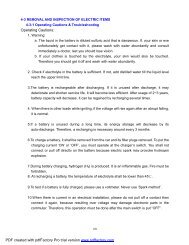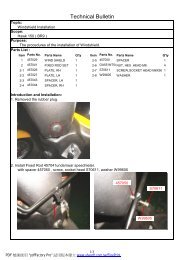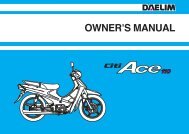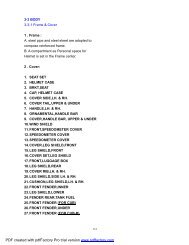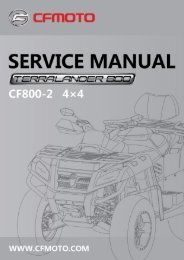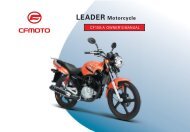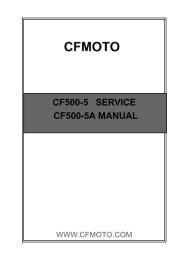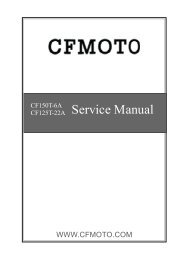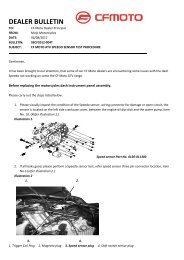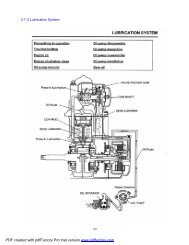**S2-125 ë´ì§060930
**S2-125 ë´ì§060930
**S2-125 ë´ì§060930
Create successful ePaper yourself
Turn your PDF publications into a flip-book with our unique Google optimized e-Paper software.
IMPORTANT NOTICEWELCOMEThank you for purchasing an Daelim vehicle. We hope you enjoy safe riding.OPERATOR AND PASSENGERThis motorcycle is designed to carry the operator and one passenger.WARNINGAttempting to change the pre-set maximum speed may cause danger and will void the Daelim warranty.ON-ROAD USEThis motorcycle is designed to be used only on the road.READ THIS OWNER'S MANUAL CAREFULLYPay special attention to statements preceded by the following words:WARNINGIndicates a strong possibility of severe personal injury or death if instructions are not followed.CAUTIONIndicates a possibility of personal injury or equipment damage if instructions are not followed.NOTEGives helpful information.This manual is an important and integral part of your vehicle. keep it with your vehicle at all times, even though your vehicle is resold.
PRIOR TO STARTING VEHICLERead user's manual carefully.Conduct maintenance checks prior to operation.Always maintain vehicle in clean status and carry out specifiedmaintenance checks.Make sure to stop engine and stay away from fire whenfueling.Exhaust gas contains harmful substance such as carbonmonoxide. Start engine in well-ventilated places.OPERATIONOperators should naturally fix bodies to keep smooth driving.Please check whether or not you are unnaturally strained andstrung up.Driving pose has a great influence on safe operation.Please always maintain the center of your body in the middle ofseat. Especially do not sit at the rear seat because it may lessenthe weight of front wheel and cause trembling steering wheel.Always hold the handlebars firmly with both hands whilingdriving, The pillion passenger should always hold on to thesuitable grab handles at the sides of the seat with both hands.otherwise, it cause severe injury or death.When wanting to turn, slightly lean to body toward thedirection of the turn. It is unsafe if the body is not moved inunion with the vehicle.Curvy roads and poor, unpaved roads constantly change insurface quality. Driving on these roads can be unsafe if certainsafety precautions are not followed.In order to safely drive through these driving conditions,anticipate coming road conditions, slow down to at least halfthe normal speed, and relax your shoulders and wrists whilesecurely holding the handles.5
CORRECT ATTIREBe sure to wear helmet and gloves at all time for seafty.Wear shirts or jackets with tight in the wheel driving.Otherwise it can be caught in the wheel to cause seriousdamage by overturn of vehicle.Many automobile/motorcycle accidents happen because theautomobile driver does not “Look” the motorcyclist.- Wear bright or reflective clothing.- Don’t ride in another motorist’s “blind spot”.Be sure to wear dress to catch an eye to avoid any crash frombehind.WARNINGBe sure you and your passenger always wear a helmet,eye protection and other protective apparel when you ride.Not wearing a helmet increases the chance of seriousinjury or death in a crash.CARGOWhen carrying cargo, you must keep in mind that operating themotorcycle, especially when turning, will be different.Make sure not to overload the motorcycle with goods as thiscan make the motorcycle unstable during operation.CAUTIONPay attention not to overload goods and fasten it tightlywhiling driving.Do not place articles between the frame body cover andengine as it is hot to be burnt.Do not place kind of cloth materials nearby oil tank cap.If the hole in oil tank cap is clogged, oil will not flow freelyinto the engine which can cause severely engine damage.Do not attach large or heavy items (such as a sleeping bagor tent) to the handle bars, fork, or fender. Unstablehandling or slow steering response may result.6
MODIFICATIONModification of vehicle structure of function deterioratesmanipulatability or causes exhaust noise to become loudershortening the vehicle life. These modifications are not onlyprohibited by law but also are the acts harmful to other people.Modifications are not covered by warranty.CAUTIONAs far as any defect caused by modifications, thewarranty will be automatically invalidated.MUFFLERPay particular attention to fellow passenger so that he/she canprevent getting burnt by the hot muffler during travel.CAUTIONBeware of muffler after driving as it is still hot to beburnt. Especially never children touch on it. And payattention to park where pedestrian zoon.If haystack or vinyl is stuck to the muffler, it might befired.ATTACHMENTExcept designated attachment by DAELIM MOTOR CO.,LTD., don't attach any extra lighting device, because it maycause an early discharging of battery.Carefully inspect the accessory to make sure it does notobscure any lights, reduce ground clearance and banking angle,or limit suspension travel, steering travel or control operation.Do not add electrical equipment that will exceed themotorcycle’s electrical system capacity. A blown fuse couldcause a dangerous loss of lights or engine power.WARNINGImproper accessories or modifications can cause acrash in which you can be seriously hurt or killed.Follow all instructions in this manual regardingaccessories and modification.7
PARTS LOCATIONREAR VIEW MIRRORBATTERYFR. BRAKE LEVERBAG HOLDERMUFFLERTIREREAR BRAKE DISKPILLION STEP8
PARTS LOCATIONRR. BRAKE LEVERMAIN SEATPILLION SEATHEADLIGHTFUEL TANK LIDREAR COMBI.LIGHTFR. FENDERFR. CUSHIONFR. BRAKE DISKAIR CLEANERBRAKE CALIPERSIDE STANDSIDE STAND SWITCHMAIN STAND9
METER READING AND USAGEMETERIndicates driving speed. Maintain legalspeed limits to ensure safe operation.Indicates total distance in kilometerstravelled by the vehicle.The fuel meter indicates the gasoline levelinside the fuel tank.Gasoline should be put in the fuel tank assoon as possible if the needle is resting inthe red area.FUEL TANK CAPACITY : 9.6RESERVIOR CAPACITY : 2.2When the fuel is low, the fuel warningindicator turns on.When this happens, fill the fuel tank withthe gasoline.WARNINGTo avoid running out of fuel, it mightcause severe injury due to engineabruptly stop.INDICATOR LAMPSWhen the winker switch is operated,the winker indicator flashes in unionwith the flashing of the turn signals.When the side-stand is down, the enginewill stop with side-stand lamp on.MILEMS(Engine Management System)isequipped with a self-diagnosis function inorder to ensure that the engine controlsystem is operation normally.If this function detects a malfunction in thesystem, the malfunction indicator lampimmediately operates.It gives the rider that malfunction hasoccurred in the system.Normally, the malfunction indicator lampilluminates for 3 seconds when the main key isturned on.If the malfunction indicator lamp does notcome on under these conditions, themalfunction indicator lamp may bedefective.After 3 seconds, the malfunction indicatorlamp off automatically. However, the MILblinks continuously, check the EMSsystem. If you are not able to check theEMS system, contact your daelim dealers.The EMS takes fail-safe function, it enablesto drive only temporary by starting even onconditioned.10
TRUNK DOCUMENT STORAGE AREA BAG HOLDERThere is a trunk under the seat.The seat is opened to gain access to thetrunk by using the main switch key onthe seat lock.The lamp inside the trunk will be turnedon if the seat is opened.TRUNK MAXIMUM LOAD:10kgCAUTIONThe temperature inside the trunkrises due to heat from the engine. Donot place foodstuffs and other articlesthat can be damaged easily by heat.Also do not place flamm-ablematerials in the trunk.Do not place valuable or fragilegoods in trunk.There is a document storage area on thebottom of the seat.Store the owner’s manual and themaintenance notebook in this area.CAUTIONAs water can enter the trunk whenwashing, make sure to removearticles that can be damaged bywater.Do not load uncloseable size ofhelmet and thing in the tunk,otherwise, the battery can bedischarged with the trunk lamp on.For ease in carrying bags and similaritems, they should be hung from thebag holder which is fitted for thispurpose.When using the bag holder, place it inthe open position and return it to thenormal position when not in use.CAUTIONDo not attempt to carry very heavy orbulky loads since this would affect thestability and steering characteristics ofthe scooter.15
Lock the rear wheel.Press the starter button without rotatingthe starter grip (opening the throttle).If engine is not started with throttle gripclosed, press starter button and openthrottle grip approximately 1/8 to 1/4.1/4 1/8Turn the main switch to an ON position.CAUTIONImmediately release the starter buttonas soon as the vehicle has started.Do not press the starter button whenthe engine is running.This can damage the start motor.Start engine with cell button.17
It is possible that starting will be moredifficult if the vehicle has not been usedfor a long period of time or if the fuelhole is plugged up(starting problemseven when there is sufficient fuel in thefuel tank may be an indication of aplugged fuel hole).When this happens, do not rotate thethrottle grip and try the starter button afew times.CAUTIONDo not keep the statter button pressed formore than 5 seconds at a time. Release thestarter button for approximately 10seconds before pressing it again.When the engine is cold morning orwinter or the vehicle has not been usedfor a long period of time, let the engineidle for a short period allow the engineto warm up.CAUTIONKeep holding rear brake until start.Exhaust has contains harmful substancesuch as carbon monoxide.Start engine in well-ventilated places.IF ENGINE CANNOT BE STARTEDIf engine cannot be started or vehicle doesnot move, check the followings.Is there fuel in fuel tank?Are you operating in accordance withthe instructions given in owner’smanual?Is fuse not cut?Is starter motor running?If starter motor is not running due tobattery consumption, charge the battery.If the MIL blinks continously when themain key is on, contact Daelim dealer.18
PROPER DRIVING METHODSBefore entering traffic, use the correctturn signal to foreward other drivers ofyour intentions.Speed is controlled by the operation ofthe throttle grip.If the throttle grip is rotated........The speed of the vehicle increases.Please rotate the throttle grip slowly.When climbing a hill, the throttle gripneed to be rotated further to give thevehicle more power.If the throttle grip is allowed torotate back........Speed decreases. This can be doneslowly or quickly, depending on howquickly you need to decelerate.Work the front and rear brakestogether.Allow the throttle grip to rotate back toits beginning position and then squeezethe brake levers.If is best to operate the brakes by firstlightly squeezing the brake levers andthen changing to a more firm squeeze.CAUTIONIf only one of the brakes is used, it ispossible for the vehicle to sliding.20
The brakes should never be suddenlyapplied and the handle bars shouldnever be suddenly turned.Sudden braking or turning can cause thevehicle to slide and tip over.It is especially dangerous to performsudden braking on wet roads or in rainyweather as the tires can lose tractionand slip easily.Special care in driving should betaken during rainy weather.More braking distance is needed whendriving on wet roads or in the rain.Reduce speed and be sure to initiate thebraking operation sooner than whendriving in normal conditions.On downgrades, allow the throttle gripto rotate back to its initial position toreduce speed, and apply the brakes anddrive slowly down the hill.It is possible for the brakes totemporarily lose operative ability afterdriving through a puddle or whendriving in the rain. To ensure that thebrakes are operating properly, slowdown(after checking for other vehicles)and while driving slowly, lightly applythe brakes to rid the brakes of anyexcess water and to dry them.Be extremely careful when driving inthe snow or on icy roads.When driving in these conditions, boththe tires lose much of their traction andthe rear tire can slip when opening thethrottle.STOPPINGWhen approaching the desiredstopping area.Activate the proper winker, and afterchecking for other vehicles, slowly turninto the area in which you want to stop.Allow the throttle grip to rotate completelyback and apply the front and rearbrakes. The brake light will shine toalert vehicles in back of you that youare stopping.21
After the vehicle has come to a completestop.Return the winker switch to the centerposition and turn the main switch toOFF. This will turn the engine off.CAUTIONDo not rotate the main switch keywhile driving. If the main switch isturned to an OFF or LOCK position,the electrical system will not operate.Operating the main switch key whiledriving can be very hazardous. Onlyturn the main switch key to OFF orLOCK position after completingstopping the vehicle.Dismount on the left side and lower themain stand on a flat surface.Be sure to park in an area that is free oftraffic. Also, the vehicle can tip over ifthe main stand is not placed on a stableand flat surface.The main stand is lowered by graspingthe handle bars with the left hand,holding the rear carrier with the righthand, and stepping firmly on the standwith the right foot. In this position, liftthe rear carrier upward, which willsecure the main stand.To prevent theft, be sure to lock thesteering when parking.CAUTIONPark in a safe area that will not blocktraffic. When you parked the vehicleafter driving, make sure foot thevehicle beyond man’s reach becauseengine and muffler are still hot.Park the motorcycle on firm, levelground to prevent it from faillingover.If you must park on a slight incline,aim the front of the motorcycle uphillto reduce the possibility of rolling offthe side stand or overturning.22
SELF INSPECTIONS BEFORE OPERATIONSelf inspect the vehicle and have regularmaintenance inspections for increasedsafety and the prevention of accidents.Regular maintenance inspections shouldbe performed even if the vehicle has notbeen used for a long period of time.Self inspections before operation shouldbe performed on a daily basis prior tooperating the vehicle.Inspections of concerned AreaBrake inspectionTire inspectionFuel checkEngine oil checkLights and winker inspectionBack mirror inspectionFuel leak inspectionLicense plate inspectionThrottle grip inspection.CAUTIONObserve safety rules when conductinginspections.Exhaust gas contains harmfulsubstance such as carbon mono-xide.Do not carry out inspections onvehicle in closed places, or in poorlyventilated places, with enginerunning.Conduct inspections on flat, solidground with the stand erected.Be careful of burns when conductinginspections immediately after engineis stopped because the engine andmuffler are hot.Stop engine and remove the key priorto the vehicle maintenance service.Use appropriate types of tools.CAUTIONIf you are unable to correct troubleeven after you make adjustment orcorrection, contact authorizedmaintenance shops, dealers ordesignated repair shops for necessaryinspection and repairs.23
INSPECTION OF CONCENED AREACheck areas which caused for concernwhen last operating the vehicle.If happened, contact authorizedmaintenance shops for necessaryinspection and repairs.BRAKE INSPECTIONLightly squeeze the brake levers untiltension is felt to check for an appropriateamount of free play. No free play in thebrake levers or overly loose brake leversare indication of a problem in the brakesystem.BRAKE LEVER FREE PLAY: 10~20mmThis is checked by placing the vehicle onits main stand on a flat surface. Make surethat the handle bars are at a horizontallevel. Check to see if the fluid is below theLOWER level.If brake fluid is significantly low, this mayindicate that there is leakage in the brakesystem. Inspect the brake hose to checkfor leaks.CAUTIONSpecified brake lever free play mustbe maintained. Excessive free playmay cause long stopping distance,brake operational fault and slowreacting time resulting in thedangerous situation and insufficientfree play may cause short stoppingdistance and damage brakesystem(pad, lining, etc.)CAUTIONIf the brake fluid is remarkably lowerthan the specified level, inspect notonly brake fluid but also check thefront brake pad for wear.24
FUEL CHECKCheck gasoline to see if there is a sufficientamount of gasoline to reach yourdestination.Place the main switch to “ON” position.If the fuel meter needle indicates Emark (red portion), fill fuel tank withgasoline as soon as possible.RESERVE FUEL CAPACITY : 2.2Open the key cover on fuel tank cap,and turn the key clockwise to removethe cap.Fill the tank with gasoline until itreaches the bottom of the level plate.Press the cap firmly, and pull out themain key.CAUTIONGasoline is extremely flammable andis explosive under certain conditions.Refuel in a well-ventilated area.Make sure to stop engine and stayaway from fire when refueling.Do not fill gasoline past the levelplate. Gasoline may leak out of thefuel tank when replacing the fueltank cap if too much gasoline is putin the fuel tank.Don’t fill low grade gasoline.Using it can cause damage (bending,getting worn, etc.) to combustionchamber and parts of fuel.Do not close the fuel cap withexcessive strength. It may cause thedamage of the cap and the rubberpacking resulting in the leak of fueland may cause fire in case ofelectrical short or the overturn of thevehicle.Avoid repeated or prolonged contactwith skin or breathing of vapor.Keep out of reach of children.25
TIRE INSPECTIONCheck for an appropriate level of airpressure by examining how the tire sits onthe ground. If you notice any abnormalities inthe shape of the tire with regard to thearea contacting the ground, use a tiregauge to check tire pressure and adjust thetire pressure to the appropriate level.Check tire tread and sides for cracks anddamage.Check tire tread and sides for nails, rocks,etc. That might have become wedged inthe tire.SIZETIREPRESSURE(kgf/ )FRONTREARWITH ONEPERSONWITH TWOPERSON120/70-12130/70-12FRONT 1.75REAR 2.00FRONT 2.25REAR 2.25Check tire tread for signs of abnormalwear.Check the wear indicator (wear limitmarking) to see if there is an insufficientamount of tread remaining.If the indicators are visible, replace tirewith a new one.26
CAUTIONIf air pressure is inadequate or if thereare cracks, damage or abnormal wearon tires, it may cause trembling steeringwheel and flat tire.Insufficient air pressure may causethe heavy steering wheel makinghandling difficult, fuel overconsumption and the excessive wearof tire outer area and excessive airpressure may cause easierwheel handling and lower fuelconsumption. But it may also causethe excessive wear of tire center area.This vehicle is equipped withtubeless tires. If you have flat tires,please contact authorised maintenanceshops for inspection.ENGINE OIL LEVEL CHECKCheck the engine oil level each day beforeriding the motorcycle.The oil level must be maintained betweenthe upper and lower level marks on thesight-glassStand the motorcycle on the main standon level ground.Start the engine and let it idle forapproximately 2~3 minutes.Check the engine oil level.If required, add the specified oil. Do notoverfill.CAUTIONTo avoid running out of engine oil, itmay cause serious engine damaged.27
28LIGHTS AND WINKER INSPECTIONCAUTIONThe lighting head light emits very hotheat. If you touch with naked hand, itmay be burned.When replacing head light lamp, stoplame and winker lamp, use only abulb of rated capacity. Using a lampexceeding the rated capacity cancause over-discharge of battery andwire burning. It can lead a fire.If the head light is turned off due toaging while driving at night, it willcause an accident by obstructingdriver’s view. Check the conditiondaily.If the tail light is off while driving atnight, it will cause an accident byfailure of notice by the other drivers.Check the condition daily.Turn a main switch “ON”. Check the lampfor proper operation (front/rear andright/left) and sound by operating theswitch, and also a lens for damage orcontamination.Turn a main switch “ON”. Check a stoplamp for proper operation by operating thefront wheel and the rear wheel brakes, andalso a lens for damage or contamination.BULB REPLACEMENT METHODBe sure to turn a main switch "OFF"prior to replacement of a bulb.Use only a bulb of rated capacity.After replacement with new bulb, checkfor proper operation.CAUTIONCare is to be taken to avoid leavingfingerprints on a headlight bulb.Failing to observe this may causeearly damage of the headlight bulbresulted from concentration of heat.Be sure to wear clean gloves whenreplacing a bulb. If touched to it withbare hands, clean it with a clothsoaked with alcohol to prevent fromearly damage.(1) Loosen 7 special screws and disassemblethe electric wire of the headlight andremove the front cover.
(2) Disassemble a headlight socket bypulling it out.(3) Disassemble the rubber cover.(4) Loosen the steel wire, and disassemblethe head light bulb.HEADLIGHT BULB: 12V 55WAdjust headlight illumination angle byturning an adjusting bolt on a headlight.(Use type screwdriver.)(1) Adjust the upper/lower by turning thescrew on outside.(2) Adjust the right/left by turning thescrew on inside.CAUTIONIllumination angle adjusted incorrectlymay dazzle a facing driver's eyes orresult in difficulty to show the forward.(1) Loosen 2 tapping screws to disassembletail light lens.(2) Press a bulb with a light force and rotateit to counterclockwise to disassemble it.(3) Replace it with new bulb. Apply reverseorder of disassembly for assembly.TAIL/STOP LIGHT BULB : 12V 21/5W(5) Replace with new bulb.(6) Install in the reverse order of remover.CAUTIONWhen disassembling, care is to be takenfor ensuring that a tail light lens can notbe damaged.When replacing a tail light lens, be sureto assemble lens seal securely.29
Front Winker Bulb(1) Loosen tapping screw to disassemble awinker lens.(2) Press a bulb with a light force and rotateit to counterclockwise to disassemble it.(3) Replace it with new bulb. Apply reverseorder of disassembly for assembly.order of disassembly for assembly.REAR WINKER BULB: 12V 10WFRONT WINKER BULB: 12V 10WREAR VIEW MIRRORCheck the objects at the back are wellnoticed when seating on a driver’s seat, andalso mirror for damage or contamination.Rear Winker Bulb(1) Loosen two tapping screws to disassemblea tail light lens and a winker lens.(2) Press a bulb with a light force and rotateit to counterclockwise to disassemble it.(3) Replace it with new bulb. Apply reverseFUEL LEAK INSPECTIONCheck there is no gasoline leakage from fueltank, hoses, carburetor, etc.30
MAINTENANCEThe Required Maintenance Schedule specifies how often you should have your motorcycle served, and what things need attention.It is essential that your motorcycle be served as scheduled to retain its high level of safety, dependability, and emission controlperformance.These instructions are based on the assumption that the motorcycle will be used exclusively for its designed purpose. Sustained highspeed operation, or operation in unusually wet or dusty conditions, will require more frequent service than specified in theMAINTENANCE SCHEDULE.Consult your authorized Daelim dealer for recommendations applicable to your individual needs and use.31
FREQUENCY ODOMETER READING(NOTE 1)ITEM1,000Km 1 4 8 12 16MONTH 1 6 12 18 24BRAKE SHOE / PAD WEARI I I I IBRAKE SYSTEMI I I I IBRAKE STOP SWITCHI I I IHEADLIGHT ADJUSTMENTI I I I ISUSPENSIONI I I IBOLTS, NUTS, FASTENERSI I I I IWHEELS / TIRESI I I I ISTEERINGI I I I IDRIVE VALTEI I I IWEIGHT ROLLERI I I ISLIDE PIECEI I I IMOVABLE DRIVE FACE GREASEL L L LREMARKIf you do not have the appropriate tools or information to conduct maintenance, or if you feel you are not capable to performmaintenance on this vehicle, contact authorized dealers or repair shops for maintenance and repairs.To ensure safety, inspections and maintenance of these parts must be carried out by dealers, or repair centers.NOTES : (1) At higher odometer readings, repeat at the frequency interval established here.(2) Service more frequently when riding in unusually wet or dusty areas.(3) Replace every 2 years, or at indicated odometer interval, whichever comes first. Replacement requires mechanical skill.33
MAINTENANCE PRECAUTIONSThe following is an explanation of correctinspection methods, cleaning and partsreplacing. Please always refer to thissection when wanting to inspect or repairyour vehicle.WARNINGIf your motorcycle is overturned orinvolved in a collision, inspectcontrol levers, cables, brake hoses,calipers, accessories, and other vitalparts for damage. Do not ride themotorcycle if damage impairs safeoperation. Have your authorizedDaelim dealer inspect the majorcomponents, including frame,suspension and steering parts, formisalignment and damage that youmay not be able to detect.Use new, genuine Daelim parts ortheir equivalent for maintenance andrepair. Parts which are not ofequivalent quality may impair thesafety of your motorcycle and theeffective operation of the emissioncontrol systems.CAUTIONAlways observe safety rules whenperforming maintenance on thevehicle.Choose a flat surface and make surethe main stand is in a secure downposition.Use correct tools.Conduct engine maintenance with theengine key out of the ignition.Be careful around the engine andmuffler when performing maintenanceas these areas can becomeextremely hot.After self maintenance, the wastematerial must be packed in thespecified container and entrusteddisposal to the authorized disposalcompany.BRAKECOMBINED BRAKE SYSTEM(How to this system works)If the front brake lever is hold, the frontbrake is operating.The rear brake lever is hold, the frontbrake and rear brake are simultaneousbrakingBoth the front and rear brakes are thehydraulic disk type.As the brake pads wear, the brake fluidlevel drops.There are no adjustments to perform, butfluid level and pad wear must be inspectedperiodically.The system must be inspected frequentlyto ensure there are no fluid leaks.If the lever free play becomes excessiveand the brake pads are not worn beyondthe recommended limit, there is probablyair in the brake system and it must bebled.See your authorized Daelim dealer for thisservice.CAUTIONBrake fluid may cause irritation. Avoidcontact with skin or eyes. In case ofcontact, flush throughly with waterand can a doctor if your eyes wereexposed.Keep out of reach of children.34
CHANGING ENGINE OILWhen the engine oil is contaminated, the lifeof engine will be remarkably shortened.Keep the proper oil level, kind and replacingperiod.Place the vehicle on a flat surface, and idle(warm up) the engine 2~3 minutes.Stop the engine, separate the oil levelgauge, place a vessel under the engine,and remove the oil drain bolt to drain theoil.Remove the adjusting hole cap, and cleanthe oil filter screen.Check the condition of O-ring of oil filterscreen.Install the oil filter screen, spring,adjusting hole cap.Install the oil drain bolt.Check the oil level gauge, and add theengine oil until it reaches the specifiedlevel (between max and min)Install the oil level gauge, and idle theengine for a while.Wait for 20~30 seconds after stopping theengine, check again the oil level gauge.WHEN CHANGING OIL: 0.9WHEN CLEANING THE FILTER SCREEN: 0.95TOTAL AMOUNT: 1.1[SPECIFIED GENUINE OIL]Don’t fill the low grade oil. Using it cancause damage to engine, and can’t receivethe warranty. Use only the genuine oil.Genuine oil: Motics 4 oilSF, SL grade (SAE : 10W40)WARNINGIf changing the oil by loosening the oildrain bolt, always clean the oil filterscreen.CAUTIONWhen changing the engine oil immediatelyafter stopping the engine, be careful notto be burned the hot oil.When refueling, make sure not to enterthe dirt into oil pouring port.If the oil overflows, wipe it clearly.Do not fill the oil past the level plate. Itcan cause damage to engine.Don’t fill the low grade oil. Using it cancause damage to engine and parts. If theengine is stuck while traveling due tothis, it may lead death or serious injury.Use only the genuine oil.Do not pour the 2 cycle engine oil.Using it can cause serious damage toengine. If the engine is stuck whiletraveling due to this, it may lead deathor serious injury.If the tire is stained with oil while orafter refueling, the vehicle may slipwhile traveling to cause roll over.Do not discard the engine oil otherthan specified place. It will bringenvironmental contamination, and bebrought under the law.37
TRANSMISSION OIL INSPECTIONStart the engine and let it idle for a fewminutes.Stop the engine and put the motorcycleon its mainstand on level ground.Check to see if transmission oil leaksout of the transmission case.Fill the recommended oil when youneed.RECOMMENDED OIL : SAE80W-90CAUTIONPay special attention not to leak out.When draining the oil, make sure thatall of the oil is removed.The engine can be harmed if there istoo much or not enough oil.Do not use low-quality oil. Theseoils can change quality overtime andcan cause damage.38
Set vehicle on main stand in uprightposition on the ground.Remove the muffler.Remove the rear caliper assembly fromthe rear swing arm by removing the 2fixing bolts.Remove the special bolt of RR.cushion securing the RR.swing armand pull it up.Lossen the axle nut and remove theRR.swing arm.Remove the collar and the rear wheel.Install in the reverse order of removal.CAUTIONIf a torque wrench was not used forinstallation, see your authorizeddealer as soon as possible to verifyproper assembly.Improper assembly may lead to lossof braking capacity.Never perform the maintenance ofthe muffler right after stopping thevehicle because the muffler isextremely hot.REAR AXLE NUT TORQUE: 12.0~13.0kgf m40
CR8EH-941
BATTERY INSPECTIONWhen removing the pillion seat and openthe battery box cover, you can find thebattery. If the battery terminal is pollutedor in-rust, separate battery and clean it.Battery terminal in rust with whitepowder should be cleaned with warmwater.In case of serious rust of batteryterminal, disassemble the battery cordand grind it with wire brush or sandpaper.CAUTIONTurn the ignition switch OFF beforedisconnecting the terminal from the battery.Disconnect the negative(-) terminal leadfrom the battery first. When connecting,connect the positive(+) terminal lead first. Ifyou work in reverse order, short circuit willoccur resulting in fire.Make sure that terminals do not contact withother adjacent parts when handling (+), (-)terminals. Contact with other parts maycause spark resulting in electrical equipmentmalfunction, fire and electric shock.Do not apply excessive impact. Whenhandling the battery, stay away fromflammable materials.If the electrolyte contact with terminal, it willbe corroded earlier.The battery is shield type, so do notdisassemble the pouring plug.When not using vehicle during a long time,take off the battery from the vehicle to keepfrom self-discharge and electric discharge.Put the battery in a well ventilated place aftercharging fully. In case it isn’t available totake battery off from the vehicle, disconnect(-) terminal.CAUTIONWhen using the battery without cover,(+), (-) terminals may be connected tocause short circuit resulting in fire.When handling the battery, stay awayfrom flammable materials.Your battery is a maintenance-free typeso check or refilling of electrolyte willnot be required. If there is anyabnormal, contact to Daelim servicecenter.If you reform the battery for car, batterywill be improperly installed to causeshort circuit resulting in fire.If the electrolyte gets into your eyes oron skin, it’ll cause a serious injury.Do not discard the battery other thanspecified place. It will bringenvironmental contamination, and bebrought under the law42
FUSE REPLACEMENTTurn off the main switch to see if the fuseis severed. If the fuse is severed, exchangethe fuse into a fuse with same capacity.Fuse is installed in fuse box around thebattery.To change a fuse, first take off fusecover. Then, remove the disconnectedfuse, and insert the reserved fuse withsame capacity.Fuse AFuse BCharging, combi S/W,regulatorWinker relay, meterlighting, horn, headlight(LO/HI), front/rear stopswitch, taillight, fuel meterCAUTIONDo not use screw driver or other metalparts to remove the fuse, as shortcircuit can be occurred to causedamage to electric system.Do not use a fuse having a largervoltage, as the wire can becomeoverheated and damaged.When replacing any of the electricalparts (lights and gauges), be sure toreplace them with the recommendedparts. Using different parts can lead tothe fuses burning out or damage to thebattery.When washing the vehicle, take specialcare not to allow to be splashed in thearea of the fuses.If the fuse immediately becomessevered after being changed with thenew one, check another problem of theelectric system. Contact to Daelimservice center.Fuse CFuse DIgnition coil, EcuO2 SensorEcu, Fuel pump relay43
AIR CLEANER ELEMENT INSPECTIONLoosen the 6 washer screws and 1flange bolt, and remove the tube clipand air cleaner case cover.Inspect the air cleaner element.If the air cleaner element is excessivelydirt or damaged, replace it with a newone.CAUTIONIf the air cleaner element isinadequately assembled, dust andother waste materials can directlyenter the engine. This results inincreased cylinder wear and reducedpower, and reduced durability of theengine.When washing the vehicle, be carefulnot to allow water to get into the aircleaner. Difficulties in starting theengine may result if this happens.If the engine start is failed duringrain or after driving across waterpool, check to see if the water isinfiltrated in the air cleaner and cleanit.Do not drive in the flooded area. Ifthe water enters the air cleaner orengine, the vehicle may be subjectedto the rear-end collision due to thepower failure.44
SIDE STAND INSPECTIONErect main stand and place vehicle inupright position on level ground.Check the spring for damage or loss oftension and the side stand assembly forfreedom of movement.Check the side stand ignition cut-offsystem;Put the side stand up.Start the engine.Lower the side stand. The engineshould stop as you put the side standdown.If the side stand system does notoperate as described, inspect it in theclosest authorized repair center.CABLE RUBBER PARTA rubber boots is assembled on the cableto protect the inner cable.Make sure that this part is placed firmlyaround the correct part of the cable. Whenwashing the vehicle, do not directly spraywater on to the rubber boots or scrub itwith brush. Use a dry cloth to clean thisarea.Check the installing condition of rubberboots daily. After adjusting the free playof throttle grip, never forget to place therubber boots to the original position.WARNINGInfiltration of the foreign materials orwater caused by damage of rubberboots (disengagement, tearing, etc.)may cause freezing in winter seasonresulting in faulty operation. It maylead death or serious injury bydecreasing of sudden acceleration andbraking force due to engine rpm.If any damage is found, replace with thenew on immediately.45
CAUTIONPetrol is extremely flammable andisexplosive under certain conditions.Perform this operation in a wellventilatedarea with the enginestopped. Do not smoke or allowflames or sparks in the area wherepetrol is drained or stored and wherethe fuel tank is refueled.Remove the battery. Store in an areaprotected from freezing temperaturesand direct sunlight.Slow charge the battery once a month.Wash and dry the motorcycle. Wax allpainted surfaces.Inflate the tires to their recommendedpressures. Place the motorcycle onblocks to raise both tires off the ground.Cover the motorcycle (don’t use plasticor other coated materials) and store inan unheated area, free of dampness witha minimum of daily temperaturevariation. Do not store the motorcyclein direct sunlight.Uncover and clean the motorcycle.Charge the battery as required. Installthe battery.Perform all Self Inspections BeforeOperation checks (page 26).Test ride the motorcycle at low speedsin a safe riding area away from traffic.46
CLEANINGMake sure to stop the engine prior tocar washing.Be careful not to allow water to enterthe muffler during the washing.Waterinside the muffler may cause animproper engine starting or rustoccurrence.Do not let water get inside the brakingsystem during the washing, as waterinside the brake system may weaken thebraking power. Upon completion ofwashing, select a safe place where thereis no traffic obstruction, and start thevehicle.Lightly apply the brake while driving ata slow speed and check the brakingpower. If the braking power has beenweak-ened, apply brake lightly whiledriving at a slow speed to dry up thebrake system.Take precautions when waxing thevehicle. Excessive polish of the paintedsection and/or the resin part withcompound wax might damage thepainted section causing discoloration ofthe affected area.GENERAL CLEANINGTo preserve the finish of metal parts andpaintwork, wash and clean your motorcycleat regular intervals, anyway according to theroad conditions you ride in.Especially during winter period through roadsalt a continuous cleaning of the vehicle isnecessary so that remove the road salt. Usespecific products only.Avoid aggressive detergents or solentsDo not wash your motorcycle right afteruse.When the motorcycle is still hot,water drops will evaporate faster andspot hot surfaces.Do not use high pressure water jets.Never aim the nozzle direct at wheelbearings, front fork seals, electric items,air inlets or exhaust pipe ends.Clean off stubborn dirt or exceedinggrease from engine parts using adegreasing agent.Be sure to avoid contact with driveparts (chain, sprockets, etc)Rinse with warm water and dry allsurfaces with chamois leather.STORAGE GUIDEExtended storage, such as for winter,requires that you take certain steps toreduce the effects of deterioration fromnon-use of the motorcycle.In addition, necessary repairs should bemade BEFORE storing the motorcycle;otherwise, these repairs may be forgottenby the time the motorcycle is removedfrom storage.Empty the fuel tank into an approvedpetrol container using a commerciallyavailable hand siphon or an equivalentmethod.If storage will last more than onemonth, carburetor draining is veryimportant, to assure proper performanceafter storage.47
FRAME AND ENGINE NUMBERThe frame number is stamped on thefront central part of the frame.The engine number is stamped on thelower part of the left crankcase.The frame and engine numbers will beused as the basis of recovering thevehicle when is stolen.Record the frame and engine numbersalong with the vehicle license platenumbers and keep them separately fromthe vehicle.48
SAFE DRIVINGPREPARATION BEFORE DRIVINGPerforming daily inspectionPutting on the protective gears (Helmet, glove, goggles, etc.)Bringing the driver's licenceDeterminating the path to the desired destinationDRIVER’SLICENSEPERFORMINGDAILYINSPECTIONFUEL,PROTECTIVEGEARS49
DRIVING METHODDRIVING POSITIONThe appropriate driving position is most important thing todriving safely.Eyes : Look at the front direction widely.Shoulders : Relieve the tension.Arms : Relieve the tension and bend arms to inside and letthem act as the spring.Hands : Grip the handle the position away from the insideend of the handle with distance of one finger tofacilitate the operation of the switch and lever.Wrist : Keep the state to act freely without applying excessiveforce to the shoulder and arms.Knees : Press the fuel tank slightly.Feet : Place the feet to face the front parallel and make thestep bar be placed in the center of feet.12345650
TAKING POSE OF FELLOW PASSENGERHands: Hold the rear grip.Feet and knees: Put the feet on pillion step, and adhere theknees closely to body.WARNINGIf the fellow passenger doesn’t hold the rear grip or putthe step on the pillion step, it may lead death or seriousinjury due to falling from the vehicle as sudden start, stopor turning.Do not operate the throttle while setting the main stand.If the fellow passenger sit on and the rear wheel touch theground, it may lead death or serious injury due to suddenstart.51
PRECAUTION WHEN DRIVINGSecure the safe distance.Drive protectively.Do not obstruct the traffic.Do not drive on the pedestrian way or walkway.Drive on the left driveway when passing away.Make sure that you can apply the brake anytime.Always apply the brake when stopping temporarily.Do not drive excessively long distance and take enoughbreak.If any abnormality is found, stop driving and contact servicecenter to inspect the vehicle.Restart the vehicle after 2~3 min when it is turned over.Always turn on the headlight at night.52
STARTINGPrior to starting always look around to avoid accident.Get on the vehicle after pulling back the stand.Start driving slowly after turning on the winker andreleasing the brake while ensuring the safety around thevehicle.CAUTIONReturn the side stand to its original position. Keepdriving without doing this may cause turnover accident.Drive the vehicle only on the driveway. Driving on thewalkway can cause accident. Also, if the wheel istransformed when advancing directly to the walkway, thevehicle can be overturned resulting in injury of the driverdue to the driving unstability.Overspeed driving on the unpaved road can cause thevehicle to be overturned resulting in injury of the driverdue to the driving unstability.Do not drive in the gravel road. If any gravel enters thewheel or engine case, the vehicle can be overturnedresulting in injury of the driver.If possible, do not drive close to the sea or on the roadwhere calcium chloride is treated.The muffler, external parts and welded parts can becorroded rapidly, and also in case of damage of the frame,the vehicle can be overturned resulting in injury of thedriver.53
TURNING METHODPRINCIPLE OF TURNEFFECT OF SPEEDThe basic principle of turn is balancing using the centrifugalforce which makes vehicle go outside and the gravity whichmakes vehicle fall inside.The centrifugal force increases in inverse portion to the radiusof a curve and in portion to the square speed. Decelerate priorto entering the curved way to reduce the centrifugal force.54
3 POSITIONS OF TURNINGThe basic principle of turn is balancing using combined force ofthe centrifugal force and the gravity.All 3 positions require straightening the head and keeping theeyes horizontally.< LEAN-WITH >This is a turning position with motorcycle and driver in a line.This position is the most natural and exact, so driver must learnit thoroughly.< LEAN-IN >This is a turning position with driver leaned inside more thanmotorcycle. This position is adequate to drive on the rained orslippy road because it has best road holding.However, special attention is required because front visual fieldis poor when driver leans inside more than motorcycle.55
LEAN-OUT >This is a turning position with motorcycle leaned insidemore than driver, which is opposite to the lean-in position.With this position, quick turn is well performed and driver canobtain wide front visual field adequate to drive on the rained orslippy road because it has best road holding. However, specialattention is required because there is danger of slipping on thebad holding road.TURNING METHODTurn the throttle grip to its original position and decelerateusing both front and rear brakes.Lean the vehicle toward inside of turn circle while drivingslowly at constant speed.Accelerate gradually.56
PRECAUTION WHEN TURNINGDo not drive inside of large truck's turn circle.< DEAD ANGLE ZONE >Dead angle zone is the sight range which cannot be identified bydriver and increases in proportion to the width of the vehicle.< DISTANCE BETWEEN THE FRONT AND REAR WHEEL TURN >It is distance between path of the front and rear wheel andincreases in proportion to the length of the vehicle.57
BRAKING METHODBASIC PRINCIPLE OF BRAKE (FRICTION FORCE)Vehicle is braked using friction between road surface andtires.Braking distance increases 1.5 times on wet road and 3times on icy road because friction force of road surface isdecreased.RESTRAINT OF BRAKE EFFECT (INERTIA)NEW TIRENEW TIRE IN ARAINY DAYEXISTINGTIRE IN ARAINY DAYDue to the inertia, vehicle does not stop immediately afterapplying the brake.58
BRAKING METHODTurn the throttle grip to its original position and decelerateusing the engine brake.Erect the vehicle straight.Brake using both front and rear brakes.IMPACT WHEN COLLISIONLearn the proper braking method to prevent accident.COMPARISION OF BRAKING DISTANCEVehicle speed : 50 km/hWhen using both front and rear brakesWhen using only front brakeImpact increases in proportion to the speed and weight. Theimpact when collision to concrete wall at 50 km/h is sameas one when falling from the height of 10m.When using only rear brake59
60WIRING DIAGRAM
MEMO :
MEMO :
2007. 03 PRINTED2007. 03 PUBLICATIONNO COPY
HEAD OFFICE(FACTORY)#58, SUNG SAN-DONG, CHANG WON, KYUNGNAM, KOREATEL: (82-55) 239-7000 / FAX: (82-2) 467-9997



